Ontario Nature Blog
Receive email alerts about breaking conservation
and environmental news.
© Lora Denis
May 23, 2019–Emma Horrigan & Dr. Julia Riley
Frequently Asked Questions (FAQ)•Reptiles and Amphibians•Species at Risk
Nesting snapping turtle © Julia Riley
Turtles, often referred to as modern day dinosaurs, with their distinctive domed, bony shell, are easy to recognize. This unique armoured architecture provides turtles with protection from predators. However, despite their protective shells, seven of Ontario’s eight species of turtles are currently listed as species at-risk under the Ontario Endangered Species Act, 2007, and face ongoing threats including habitat loss and fragmentation, road mortality, and increased nest predation.
In Ontario, turtle nesting season can begin as early as May and can last until mid-July, depending on the year and location (Figure 1). Female turtles select nesting sites based on numerous factors, including: soil characteristics (sites with loose, sandy substrate) and exposure to the sun. Beaches, shorelines and the shoulders of roads are often selected as nesting sites for these reasons. Nesting along roads can result in high rates of turtle mortality, as female turtles expose themselves to a direct threat (vehicle traffic) while trying to access road shoulders to lay their eggs.
Across the province, hatchling turtles typically emerge from their nests in mid-August through to September. While this is the case for many turtle species, some species, such as Painted and Map Turtles, spend the winter in their nest chamber after hatching from their eggs and don’t emerge from the nest until April or May the following spring! If you are wondering what you can do to help Ontario’s turtles, read on to find out the most frequently asked questions related to turtle nests and the practical stewardship actions you can take:
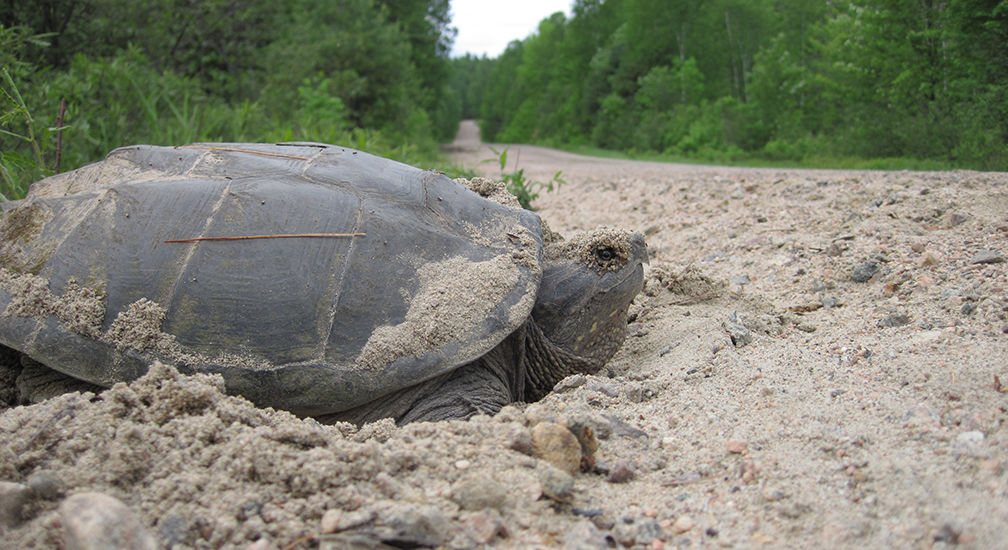
During this time of year you are seeing more turtles, especially females, as they are searching for a nesting location. Sometimes female turtles will cross a road to access a wetland, or are searching for a nesting site on or nearby a road (Figure 2).
If the turtle has not started nesting yet and is on the road, and keeping your own safety in mind, move the turtle off the road in the direction it was headed. Step-by-step video instructions on how to move turtles can be viewed here. Apart from moving turtles off roads and out of harm’s way, it is illegal to capture and move any of Ontario’s turtle species. Turtles should never be transported to new locations, even if the habitat where the turtle is headed does not look ideal.
All turtle sightings can also be reported to the Ontario Reptile and Amphibian Atlas (Atlas). The Atlas is a citizen science project that tracks distribution and spatial trends of reptiles and amphibians across the province, over time.
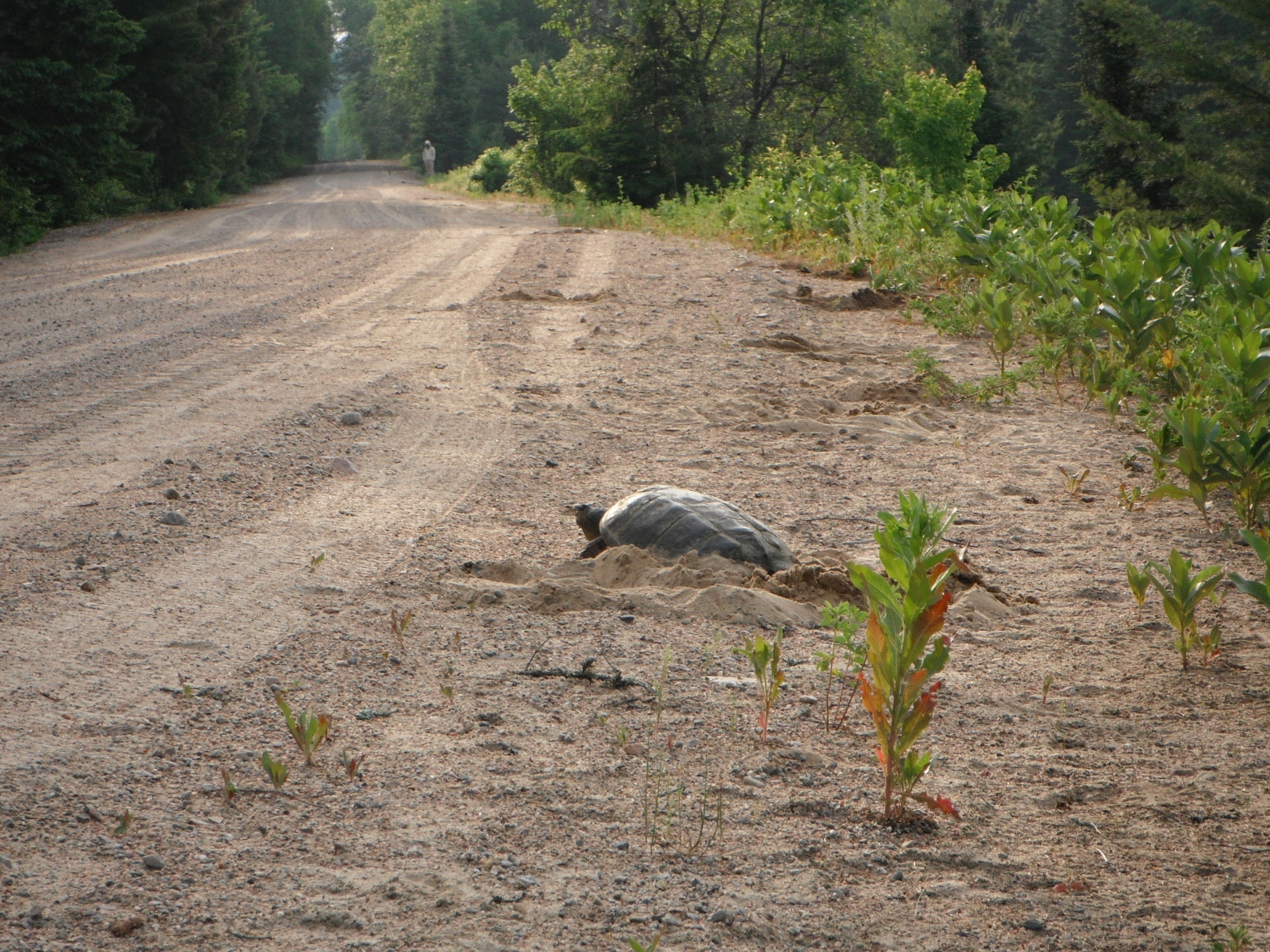
After you have safely pulled off of the road, keep your distance away from the female (at least 10 metres) to ensure that the nesting process is not disturbed. The nesting process involves: searching for the nest location, digging the nest, laying the eggs, and burying the nest. Depending on the species, temperature, and individual, turtle nesting can last anywhere from 10 minutes to 1 hour. After the female has covered her nest, observe the direction she heads. If she tries to move across the road follow the directions outlined in question 1.
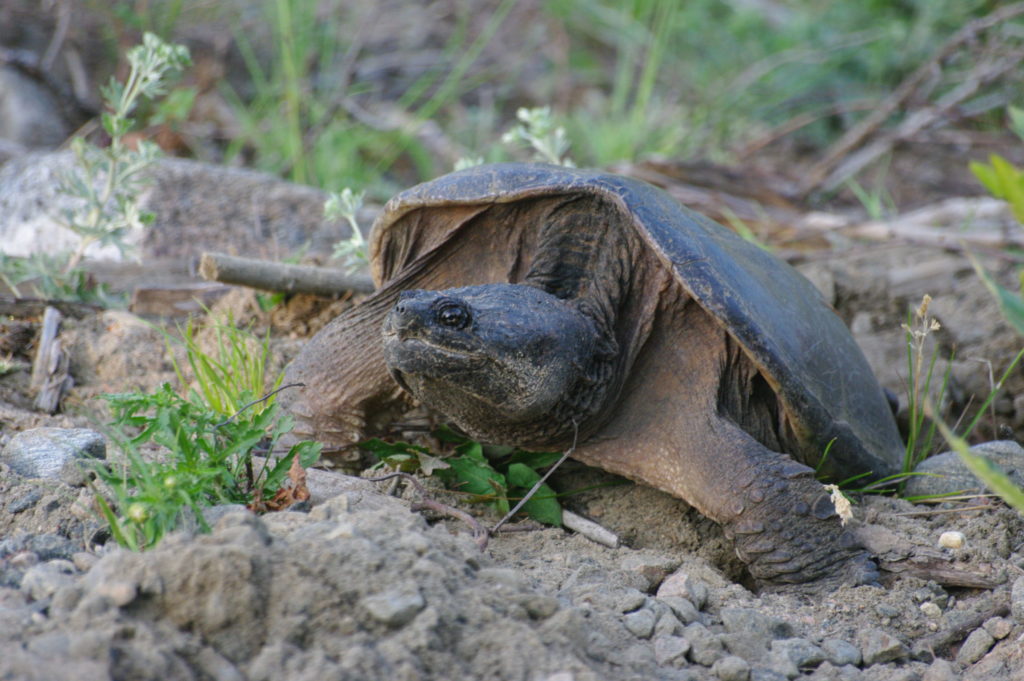
Take care to observe the female turtle from a distance (at least 10 metres) to minimize disturbing the nesting process. If a female is spooked repeatedly, or in a way that is very stressful, she may end up ‘laying’ her eggs in the water. Retaining the eggs can be harmful to the female, and if the eggs are laid in water they will not survive.
In most cases, there is no reason to engage with the female turtle or her eggs. Sometimes there are exceptions (e.g. landscaping or renovation projects that lead to the destruction of a nest) and in these cases you should contact your local Ministry of Natural Resources and Forestry (MNRF) office or the Ontario Turtle Conservation Centre. They will try to work with you to find a solution that works for everyone.
Another exception is when a large number of predators (i.e. foxes, racoons, wolves, crows) are known to be near your house or cottage (Figure 3). In this case, covering a nest with a cage may help to protect it from predation during incubation.
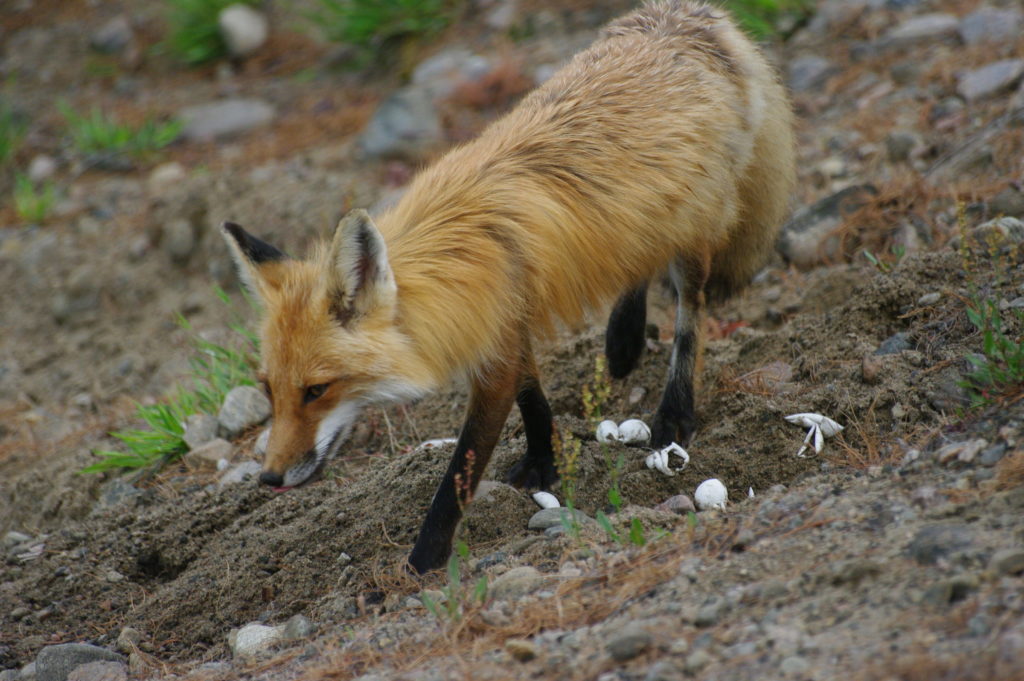
Before deciding to interfere with a nest, there are a few questions you should ask yourself first.
Is a cage necessary? Generally, experts would recommend you think carefully about whether or not a protective cage is necessary. The predation of turtle nests is a part of nature and provides a food source for many predators, and turtle populations are adapted to relatively high levels of nest predation. However, in many parts of Ontario, populations of nest predators are much higher than they would have been historically due to human activities (e.g. cities support unnaturally high racoon populations). In areas with large populations of “subsidized predators”, nest predation rates may by unsustainably high over the long term, and management actions, such as nest protection, may be warranted. Keeping this in mind, the Ontario Turtle Conservation Centre (OTCC) or other turtle experts can help to determine if and when nest caging may be appropriate.
If the nest is in a natural area, do not cage the nest. Many parks manage their own turtle populations with practices determined through years of scientific study. Furthermore, an authorization from the park is often required to conduct monitoring, research or other conservation activities such as nest caging.
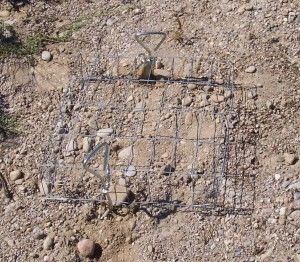
If you do decide to protect a turtle nest with a cage, we recommend the following guidelines:
Authorizations under the Ontario Endangered Species Act and Fish and Wildlife Conservation Act may be required if these guidelines are not adhered to (e.g. if the nest environment is altered in any way, or if the cage does not allow the hatchlings to leave on their own).
Setting up effective nest caging takes a lot of time and consideration, so please think carefully before taking on this responsibility.
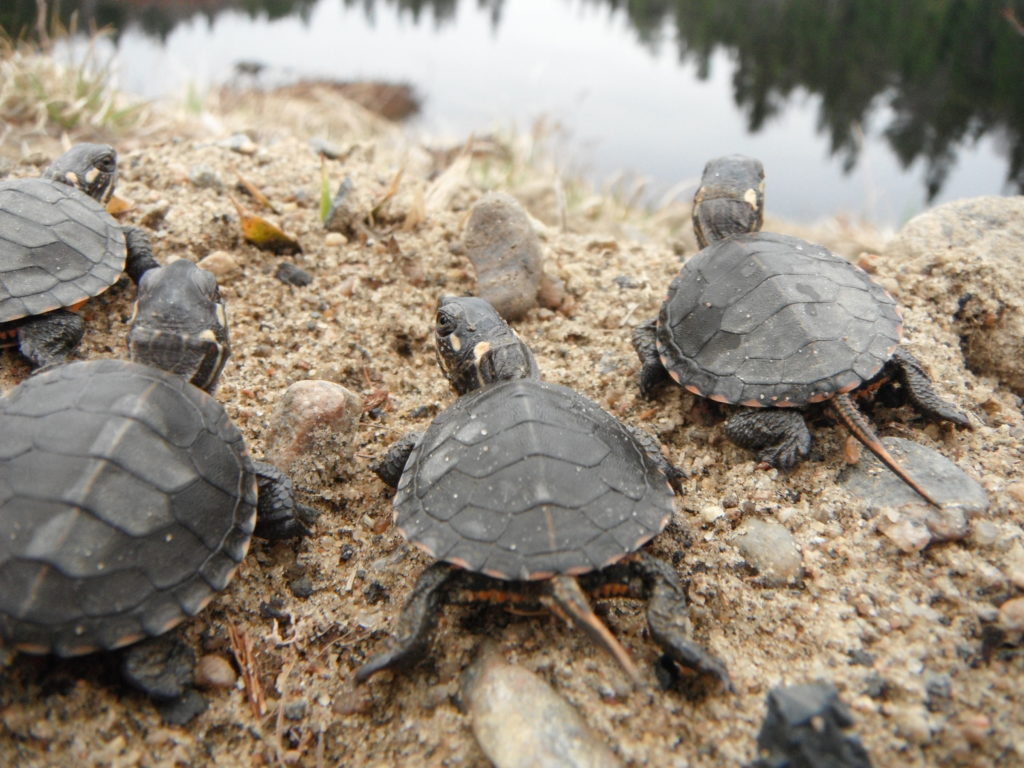
This is another scenario where you can sit back, and enjoy watching nature in front of you! Soon after emerging from their nest, hatchlings begin to move to the nearest waterbody or other appropriate habitat (Figure 5).
It may seem like hatchlings could be vulnerable to predators, and need your help. And while the first statement is true, it is important to remember that predation is a natural occurrence in nature. Not much is known yet about how turtles navigate the landscape and how or when turtles learn important cues, but many experts believe that the movement from nest to water is an important time in the life of a turtle.
That being said, if you find hatchlings emerging from a nest on the side of a busy road it is recommended that they be moved off the road in the direction they were headed. While it is not advisable to move hatchlings at all, in this scenario if they are not moved there will be few survivors due to the grave risk traffic poses.
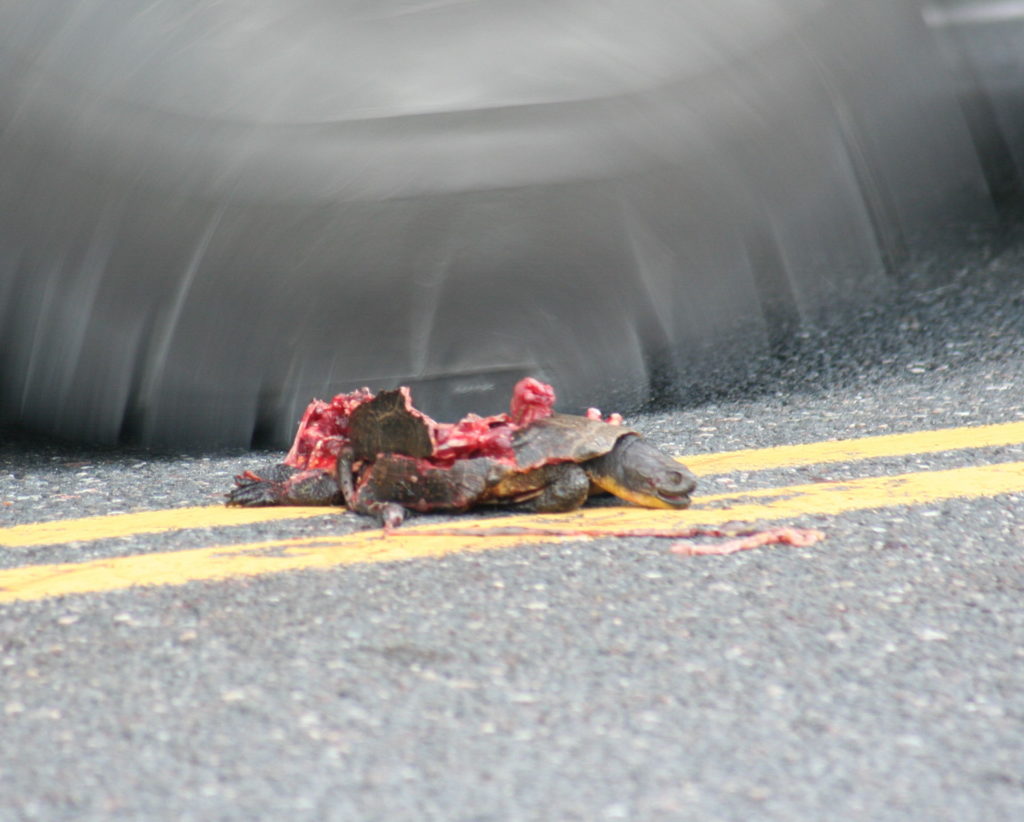
If you can, safely and gently remove the turtle from the road. Record your exact location, and place the turtle (and her intact eggs, if it is a gravid female) in a box or container. The container should be well ventilated with a secure lid, and if available, lined with a slightly damp towel.
Then, as soon as possible, contact the OTCC by phoning 705-741-5000. The OTCC will arrange pickup and delivery of the injured turtle to their rehabilitation centre. The OTCC has the largest rehabilitation centre for turtles in the province, and has an extensive volunteer network that works together to transport turtles to their facilities.
If a gravid female cannot be rehabilitated, her eggs may still be viable, and with careful incubation, hatchlings can be released at the site where the female was found. This action is so important for turtles – not only do you have the ability to save a mature, adult, female turtle but also her offspring.
Thanks for reading and your interest in helping turtles! You can be a turtle hero today by following these simple stewardship guidelines and actions.
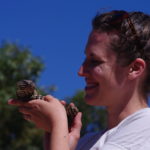
Dr. Julia Riley is an ecologist and herpetologist currently based at the University of New South Wales in Sydney, Australia. Before moving to Australia her research focussed on the biology, behaviour, and conservation of Ontario turtles, and she still continues work on this topic today. If you want to know more about her current research, check out her website at: www.rileybiology.com.

Emma Horrigan is Ontario Nature’s Conservation Projects and Education Manager. Besides her passion for ecology, Emma enjoys cross-country skiing, birding and hiking.
Proposed 413 Route, Old School Road with farm and escarpment view © Noah Cole
My husband and I were ridding our jet skis in Kingston Ontario up the Rideau by the locks. On the side of the river we saw two big turtles on the rocks with a bunch of baby turtles that all plopped into the water as we approached. Up a little further we saw this exact same thing again. Everything I have read says they do not stick around and seems to be the wrong month. What can you tell me about this?
Will a snapping turtle lay unfertalized eggs? We have seen turtles lay eggs on our property close to the lake in Ontario, but never seen any hatch?
I have found 5 eggs on my property. One here, one there. Almost like a trail to the water. I have moved them to avoid mowing them but what should i do with them? They weren’t buried. Last year, the eggs were dug up and eaten so i feel weird about leaving them on the surface. Any help would be very much appreciated
Hi Crystal,
That is a good question.
It’s a bit of a mystery as to why they are there. It could be that an animal did dig them up and mistakenly dropped them along its course. Or, maybe a turtle couldn’t quite make it to the nesting site before those eggs.
It is quite possible that the eggs are no longer viable, but there are two streams of thought. You could leave them for other wild animals to opportunistically find. Or, far away from other nests in an appropriate area, you could try to dig a nest hole for them to attempt to help recover the species.
Kind regards,
Noah
I watched a female snapping turtle laying her eggs on the roadside; there is a marsh three feet away on the same side of the road as the nest. On the other side is a house and Lake Ontario. I have learned that the home owner digs up the eggs every spring and moves them to the other side of the road (the lake side). He does this because the mailbox is six feet from the nest and he thinks the mail delivery car might run over the nest area. However… now the hatchlings would have to cross the (busy) road to get to the marsh! I am appalled at this misguided behaviour and would like your advice on how to proceed. It’s illegal to move eggs, isn’t it? At the very least it’s stupid. Please advise. Thank you.
I live in Prince Edward County.
A man in the neighborhood styles himself as the local turtle expert and has taken it upon himself to protect turtle nesting sites with cages he has made. He occasionally digs up a nest to see if all the eggs have hatched, and when the hatchlings emerge, he gathers them up and takes them to the creek, which is several hundred yards away through thick undergrowth (or sometimes across a lawn). I was under the impression that the hatchlings need to find their own way to the water and are usually successful at doing so. Is what he’s doing a good practice?
Hi Pat,
Thanks for sharing this. This is unfortunate to hear. It is not legal (nor do we recommend) digging up turtle nests and transporting hatchlings. Here is the exact wording from the blog regarding hatchlings:
It may seem like hatchlings could be vulnerable to predators, and need your help. And while the first statement is true, it is important to remember that predation is a natural occurrence in nature. Not much is known yet about how turtles navigate the landscape and how or when turtles learn important cues, but many experts believe that the movement from nest to water is an important time in the life of a turtle.
To address the comment about caging, as outlined in the blog, we also suggest thinking carefully about interfering with a nest and don’t recommend caging a nest if it is in a natural area.
Noah
Hello,
I am new to keeping turtles. I am currently trying to prepare a suitable nesting area for my red eared slider. I have her indoors in a 55 gallon long. I am unable to make an outdoor pond and have received conflicting advice. Any information would be greatly appreciated.
Darin
Thank you for the very informative page. I found some eggs in the shallow part of a river and I know that eggs will not survive in water, so I was wondering if there was anything I could do to help them.
Hi Julie,
Thank you for asking and sorry for the delay.
As a firm rule it is important not to move turtle eggs. I am not sure what may have occurred by now – though if you’re able try giving the Ontario Turtle Trauma Centre a call to see if they have advice; https://ontarioturtle.ca/contact/ . Alternatively, call Scales Nature Park, the team at Scales will be able to coordinate good advice as well; https://www.scalesnaturepark.ca/
ON Noah
There is a pond behind our yard that has snapping turtles in it. There’s been a turtle I n either our front or backyard yard for at least 8 hours. As there is a chain link fence between our yard and the pond, I believe that she has laid eggs in our yard and now can’t find her way back to the pond. Should we just leave her alone or should we help her get back into the pond? I can’t find an obvious place of where the loads have been laid.
A snapping turtle laid eggs on our front lawn and I took video – you can see the eggs drop. Let me know if interested
There are at least two turtle nests on my lawn. We’re on our third summer living on Vardy Lake. This is a very new experience. Yesterday, I was able to watch the mother put the eggs in the ground just below our deck. Today, another turtle laid a nest further on lawn. What can I do to ensure these nests are protected?
Hi Aileen,
As in Point # 3 above;
“3. I have come across a female turtle nesting (somewhere other than on a road) or searching for an appropriate nesting location. What can I do?
Take care to observe the female turtle from a distance (at least 10 metres) to minimize disturbing the nesting process. If a female is spooked repeatedly, or in a way that is very stressful, she may end up ‘laying’ her eggs in the water. Retaining the eggs can be harmful to the female, and if the eggs are laid in water they will not survive.
In most cases, there is no reason to engage with the female turtle or her eggs. Sometimes there are exceptions (e.g. landscaping or renovation projects that lead to the destruction of a nest) and in these cases you should contact your local Ministry of Natural Resources and Forestry (MNRF) office or the Ontario Turtle Conservation Centre. They will try to work with you to find a solution that works for everyone.
Another exception is when a large number of predators (i.e. foxes, racoons, wolves, crows) are known to be near your house or cottage (Figure 3). In this case, covering a nest with a cage may help to protect it from predation during incubation.”
Warm regards,
ON Noah
Hi Sharon –
Please email info@ontarionature.org with specifics like location. We can see what we can do to help you.
Cheers,
ON Tanya
This has been the worst year yet for saving turtles. We had a late and lousy Spring so, perhaps that also contributed. Last year by this time I had saved 5+ turtles. Most of them came between June 9th -15th. 15th being my busiest day. And even on the roadside and roads there were hardly any deaths… In our area Quinte West -Belleville,they are paving the shoulders everywhere so, the turtle nesting sites are few now.. I had started to do the Atlas last year ,and started to input my info but , I had cellphone troubles and all info was in the old phone… Is it too late to somehow record or note the info… thank you for all you do. DS p.s. am I able to upload some pics pertainng to turtles to this site. Taken last month?
Hi Deborah,
Thank you very kindly for saving the turtles and thank you again for reporting your considerate and important actions.
It is not too late to report your sightings. Visit https://ontarionature.org/programs/citizen-science/reptile-amphibian-atlas#report and you can report your sightings to the atlas.
Best regards,
ON Noah
We need a guest speaker to explain the connections between keeping our properties in a natural state and survival of endangered species. We have Eastern hog nosed snakes. Five-lined skinks and painted turtles in our area and need heightened awareness of importance of woodland conservation. Can you help us?